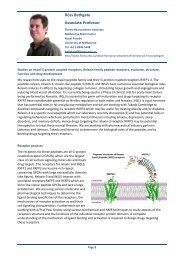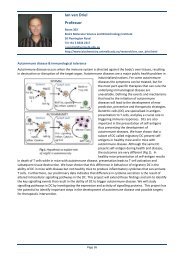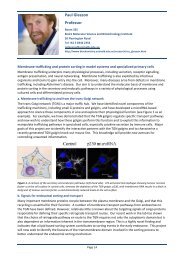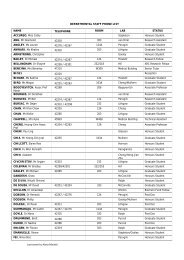Danny Hatters Grimwade Fellow - Department of Biochemistry and ...
Danny Hatters Grimwade Fellow - Department of Biochemistry and ...
Danny Hatters Grimwade Fellow - Department of Biochemistry and ...
Create successful ePaper yourself
Turn your PDF publications into a flip-book with our unique Google optimized e-Paper software.
Structural analysis <strong>of</strong> oligomers<br />
formed in mammalian cells<br />
This project involves determining the<br />
structural <strong>and</strong> biochemical<br />
properties <strong>of</strong> oligomers <strong>of</strong> mutant<br />
huntingtin protein <strong>and</strong> how they<br />
assemble into inclusions. The work<br />
will use live cell imaging <strong>and</strong><br />
advanced fluorescence imaging <strong>and</strong><br />
flow cytometry techniques.<br />
A bead model <strong>of</strong> the Huntingtin monomer fused to CFP. Derived from our small<br />
Live cell imaging <strong>of</strong> huntingtin<br />
angle x‐ray scattering experiments with Dr Mulhern.<br />
aggregation in Drosophila (with Dr<br />
Leonie Quinn, Dept <strong>of</strong> Anatomy <strong>and</strong> Cell Biology)<br />
We have developed Drosophila models for HD to<br />
determine how defects in protein conformation <strong>and</strong><br />
aggregation affect neural functioning. The aim <strong>of</strong> this<br />
project is to determine the physiological changes that<br />
lead to HD in vivo.<br />
Determining the interplay between two “garbage<br />
disposal” mechanisms for problematic proteins<br />
This project will investigate the processes that cells use<br />
to process unsalvageable proteins, such as mutants that<br />
cannot fold properly. In this project, the student will<br />
study how these mechanisms operate using specially<br />
designed “problem” proteins <strong>and</strong> a collection <strong>of</strong> disease<br />
associated proteins from a range <strong>of</strong> neurodegenerative<br />
diseases.<br />
Heat shock chaperones (green) <strong>and</strong> huntingtin<br />
inclusions (red) in mouse neuroblastoma cells.<br />
Recent publications:<br />
1. Polling, S., Hill, A. F., <strong>and</strong> <strong>Hatters</strong>, D. M. (2012) Polyglutamine aggregation in Huntington <strong>and</strong> related diseases, in T<strong>and</strong>em<br />
Repeat Polymorphisms: Genetic Plasticity, Neural Diversity <strong>and</strong> Disease (Hannan, A. J., Ed.), L<strong>and</strong>es Bioscience, Austin.<br />
2. <strong>Hatters</strong>, D. M., <strong>and</strong> Griffin, M. D. (2012) Diagnostics for amyloid fibril formation: where to begin., in Protein Folding,<br />
Misfolding, <strong>and</strong> Disease (Hill, A. F., Cappai, R., Barnham, K., <strong>and</strong> Bottomley, S. P., Eds.), Humana Press.<br />
3. Mok, Y. F., Ryan, T. M., Yang, S., <strong>Hatters</strong>, D. M., Howlett, G. J., <strong>and</strong> Griffin, M. D. (2011) Sedimentation velocity analysis <strong>of</strong><br />
amyloid oligomers <strong>and</strong> fibrils using fluorescence detection. Methods 54, 67‐75.<br />
4. Irtegun, S., Ramdzan, Y. M., Mulhern, T. D., <strong>and</strong> <strong>Hatters</strong>, D. M. (2011) ReAsH/FlAsH labeling <strong>and</strong> image analysis <strong>of</strong><br />
tetracysteine sensor proteins in cells. J. Vis. Exp., Accepted 3 Jan, 2011.<br />
5. Bernoux, M., Ve, T., Williams, S., Warren, C., <strong>Hatters</strong>, D., Valkov, E., Zhang, X., Ellis, J. G., Kobe, B., <strong>and</strong> Dodds, P. N. (2011)<br />
Structural <strong>and</strong> functional analysis <strong>of</strong> a plant resistance protein TIR domain reveals interfaces for self‐association, signaling,<br />
<strong>and</strong> autoregulation. Cell Host Microbe 9, 200‐11.<br />
6. Tetali, S. D., Budamagunta, M. S., Simion, C., den Hartigh, L. J., Kalai, T., Hideg, K., <strong>Hatters</strong>, D. M., Weisgraber, K. H., Voss, J. C.,<br />
<strong>and</strong> Rutledge, J. C. (2010) VLDL lipolysis products increase VLDL fluidity <strong>and</strong> convert apolipoprotein E4 into a more exp<strong>and</strong>ed<br />
conformation. J Lipid Res 51, 1273‐83.<br />
7. Ramdzan, Y. M., Nisbet, R. M., Miller, J., Finkbeiner, S., Hill, A. F., <strong>and</strong> <strong>Hatters</strong>, D. M. (2010) Conformation sensors that<br />
distinguish monomeric proteins from oligomers in live cells. Chem Biol 17, 371‐9.<br />
8. Olshina, M. A., Angley, L. M., Ramdzan, Y. M., Tang, J., Bailey, M. F., Hill, A. F., <strong>and</strong> <strong>Hatters</strong>, D. M. (2010) Tracking Mutant<br />
Huntingtin Aggregation Kinetics in Cells Reveals Three Major Populations That Include an Invariant Oligomer Pool. J. Biol.<br />
Chem. 285, 21807‐21816.<br />
9. <strong>Hatters</strong>, D. M., Voss, J. C., Budamagunta, M. S., Newhouse, Y. N., <strong>and</strong> Weisgraber, K. H. (2009) Insight on the Molecular<br />
Envelope <strong>of</strong> Lipid‐bound Apolipoprotein E From Electron Paramagnetic Resonance Spectroscopy. J. Mol. Biol. 386, 261‐71.<br />
10. Coleman, B. M., Nisbet, R. M., Han, S., Cappai, R., <strong>Hatters</strong>, D. M., <strong>and</strong> Hill, A. F. (2009) Conformational Detection <strong>of</strong> Prion<br />
Protein with Biarsenical Labeling <strong>and</strong> FlAsH Fluorescence. Biochem Biophys Res Commun 380, 564‐8.<br />
11. <strong>Hatters</strong>, D. M. (2008) Protein Misfolding Inside Cells: The Case <strong>of</strong> Huntingtin <strong>and</strong> Huntington's Disease. IUBMB Life 60, 724‐8.<br />
Page 19









